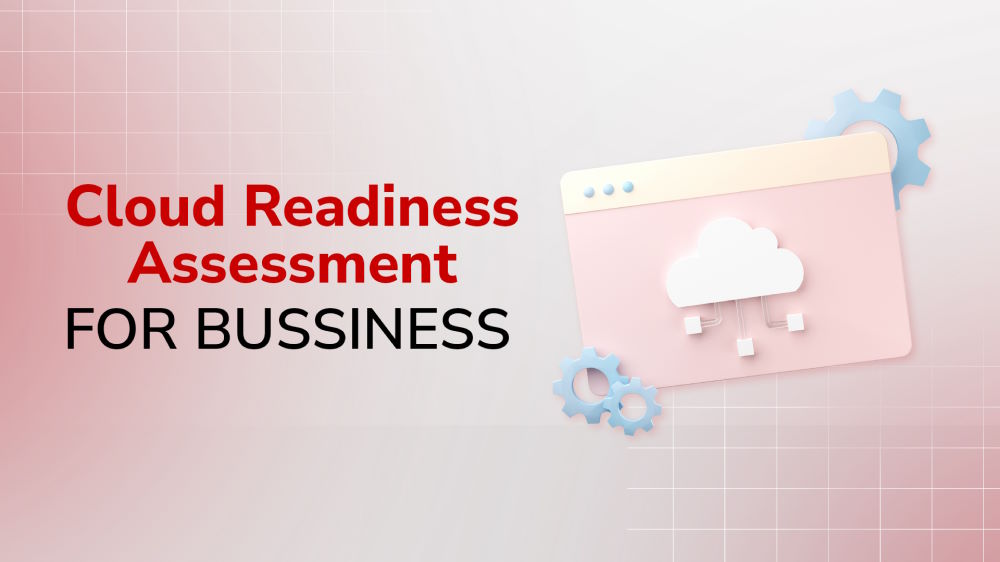
5 Simple Steps to Implement a Successful Cloud Migration Assessment

Content Map
More chaptersIn recent years, the pervasive shift of businesses towards cloud technology has emerged as a defining trend, reshaping the modern enterprise landscape. Based on the current cloud adoption rate, the cloud services market is estimated to generate $3 trillion in EBITDA value by 2030. Instead of managing and storing data in traditional on-premises infrastructure, cloud computing signifies a strategic pivot towards empowering agility, scalability, and innovation by leveraging remote servers hosted on the Internet.
However, not every business qualifies to start a cloud migration journey since it requires many resources, scalability, performance, and security standards. Cloud migration assessment comes in this situation as a solid foundation to ensure a smooth transition and define an aligned migration strategy for specific cloud migration objectives.
So, what is cloud migration assessment? Why do we need such processes? How do you implement a thorough cloud readiness assessment? Which are the best tools for assessment in migration phases? Find your answers in this article.
Understanding Cloud Migration Assessment

Cloud migration assessment is the process of strategically examining and analyzing an organization’s existing IT environment and workloads to ascertain their suitability for migration to the cloud. At its essence, cloud migration assessment entails evaluating multiple factors, including performance considerations, data storage needs, and security requirements, to identify potential roadblocks that may arise during the transition process.
Through comprehensive review and checklist, businesses gain valuable insights that demonstrate clarity on the technical intricacies, resource implications, and potential benefits related to migrating specific workloads to the cloud, ultimately supporting businesses to make informed decisions on the next steps across cloud strategy.
The Importance of Cloud Readiness Assessment Before Starting Cloud Migration Process

It is undeniable that a successful cloud adoption brings businesses countless benefits. However, the final outcomes are uncertain since the implementation process has not yet occurred. This uncertainty has made many organizations skeptical about the effectiveness of cloud adoption processes. Are the results worth the effort and budget?
To better understand the relationship between implementing cost and received benefits, performing cloud readiness assessment in the initial phases is the most optimal solution. Below are some reasons businesses should perform cloud migration assessments before starting the main stages.
Understanding of the Current State
If developing software business ideas is mainly based on market surveys, deciding whether to apply cloud technology to operations or not depends on the results of the evaluation process of the existing IT infrastructure (e.g., the hardware, servers, networking equipment, and other physical components), related applications, and data architecture. With cloud migration assessment, businesses have a comprehensive view of the company’s current state, thereby determining which components need to be migrated and ensuring the transition is always smooth.
Cost Estimation
Every operational activity of a company requires a certain budget, and cloud migration is no exception. In order to avoid wasting the budget on unnecessary tasks or budget overruns, it is a wise choice to perform a cloud migration assessment before proceeding to the main steps.
An assessment plays an important role in estimating the costs associated with cloud migration, including infrastructure, software, and ongoing operational expenses. By conducting a thorough assessment, companies can gain clarity on the economic viability of migrating to the cloud, evaluate potential cost savings, and make informed decisions regarding budgetary considerations and resource allocation.
Risk Analysis
Similar to software testing, cloud migration assessment is also an efficient method of identifying potential risks associated with the migration process, such as data security, service interruptions, compliance issues, and application performance. Instead of exposing the entire infrastructure to vulnerabilities during the cloud migration deployment process, assessment multiple times helps businesses detect and take timely repair measures, avoiding negative impacts on data transmission.
As cloud storage specializes in storing valuable data, assessing the existing security and compliance measures plays an even more important role. By evaluating data governance requirements, encryption protocols, and access controls, organizations can fortify their data integrity and privacy posture in the cloud environment and ensure no threats violate industry regulations during and after the migration process.
Resource Planning
Not only does it help optimize financial plans, but cloud migration assessment also allows businesses to determine the skills and resources needed for a successful cloud migration.
If the assessment results reveal that the company’s existing development team lacks expertise in managing cloud environments, business owners may consider providing appropriate training sessions to its current IT staff like Microsoft Azure, investing in support tools support, or even hiring a cloud architect to lead and oversee the migration project. Deciding whether to outsource the data migration process to a third-party cloud service vendor also depends heavily on conducting a comprehensive assessment.
A Step-by-step Guide to Perform Efficient Cloud Migration Assessment

Implementing cloud migration is not simply a way to leverage the cloud’s transformative potential and nurture a culture of innovation; it gives businesses unprecedented opportunities for growth and transcends traditional operational constraints in an era defined by rapid technological evolution. However, implementing this process in the wrong way brings no benefits other than loss of time and budget.
The efficient migration process involves a multitude of steps, typically starting with a thorough cloud readiness assessment phase. Whether your cloud journey will be as successful as expected depends on the results of this initial stage. Here is a step-by-step guide to help you perform an efficient cloud migration assessment.
Step 1 - Objective Understanding
As the strategic migration assessment process brings countless benefits, businesses may lose track during implementation if objectives aren’t clearly stated. This step may seem like a waste of time, but it is a checklist that helps you evaluate the progress and level of completion of the assessment. Typically, you will need to pay attention to two main types of objectives, including business and technology objectives.
Business objectives refer to broader business goals that a company hopes to accomplish throughout the cloud migration, such as improving operational efficiency, optimizing financial planning, enhancing user experience, or enabling faster time-to-market for new products or services. In contrast, technology objectives represent specific technical benefits the organization seeks to achieve from the cloud migration process. Examples include modernizing legacy systems, increasing scalability, or achieving better disaster recovery capabilities.
The goal-setting process needs to be carried out with the cooperation and discussion of key stakeholders across various organizational functions. This helps businesses ensure their expectations are considered when defining their objectives and goals, leading to better satisfaction.
Step 2 - Inventory Analysis
The next step is to thoroughly examine and document all existing infrastructure, applications, and data currently used in your IT landscape, including both customer-facing and internal systems, to identify which components need replacing or modifying.
Regarding infrastructure and applications, it is worth mentioning that they should not be simply named. On the contrary, businesses need to list them in accordance with their individual functionality and interdependencies to determine their relevance to the business and their potential impact on the migration.
Regarding data, clearly identify the origin of the data, such as databases, file storage, and other repositories, and also classify them based on sensitivity, criticality, and regulatory requirements, which impacts how it should be handled during the migration to later identify migration waves.
Step 3 - Application Dependencies Assessment
After listing all the infrastructure currently in use, businesses need to specifically assess and understand how different applications within an organization are interconnected and reliant on underlying infrastructure components. For instance, a software application might depend on a server, database, or API to function properly.
By identifying dependencies, businesses can assess the impact of one application on others, ensuring that critical workflows are managed efficiently to minimize any disruptions to functionality, data flow, or performance that might occur during the migration process.
Based on the list of existing infrastructure listed and documented in the step above, it is advised to take advantage of the dependency map to gain a comprehensive view of the entire ecosystem of interdependencies. As a visual representation that illustrates interdependencies between different applications and their underlying infrastructure, a dependency map is an efficient tool to help visualize and simplify the relationships between related components.
Step 4 - Performance, Security, and Cost Analysis
It is time to take a closer look at each application and data workload within the organization, regardless of whether they are chosen to be migrated to the cloud or not. Although this step is time-consuming and certain applications may not be immediately planned for cloud migration, it greatly strengthens the decision-making and future planning process.
Regarding performance, evaluate optimization applications through criteria such as workload assessment, scalability, and opportunities. Regarding security, consider sensitivity level, compliance and regulatory requirements, and access management. Regarding costs, various factors are taken into account, which include software licensing, infrastructure costs, operational expenses, and training costs.
The purpose of these small steps is to help business owners make informed decisions about the migration process, thus ensuring that the selected cloud environment meets the technical, security, and financial requirements of the applications and data workloads.
Step 5 - Cloud Provider Selection
While it is feasible to conduct cloud migration assessment using an in-house team, it is worth noting that such a process requires much expertise in cloud technologies, security, compliance, and cost analysis, as well as dedicated time and resources. If your business lacks one of these conditions, seeking external cloud consultants or experts to validate the assessment findings is a safer and more effective choice.
However, there are a multitude of service providers available in the market. Which cloud provider is the best fit for your organization? In order to determine which third-party vendors are suitable, cloud provider selection is an extremely necessary process. The process of selecting service providers from start to finish usually includes the following steps.
1. Conduct thorough research on various cloud service providers.
2. Compare vendors by considering factors such as reputation, reliability, performance, support, available services, security measures, pricing models, and cost structures.
3. Consider conducting a proof of concept or trial with the shortlisted providers to evaluate their services in action.
4. Choose the most suitable cloud provider that meets your unique needs.
In case you have enough resources to implement a cloud adoption plan without asking for help, skip the above four steps and develop a detailed migration strategy immediately. The development plan needs to be built upon the assessment findings and outline the migration sequence, timeline, resource allocation, and testing procedures.
Cloud Migration Assessment Tools for Smooth Transitions in the Cloud Environment

There are a number of useful tools that help businesses conduct thorough assessments of their existing infrastructure, workloads, and applications to facilitate a seamless and successful migration to the cloud. As each tool has its own unique features, it is vital to evaluate them based on specific organizational needs and requirements before use.
- AWS Discovery Service: Amazon Web Services (AWS) helps businesses gather information about on-premises data centers, servers, and their dependencies.
- Azure Migrate: Microsoft Azure offers assessment capabilities and insights into dependencies, performance metrics, and cost estimations.
- Cloudamize: Cloudamize provides a platform for automated discovery and assessment of workloads to determine the best-fit cloud provider.
- Carbonite Migrate: Carbonite Migrate assists in workload assessments, dependency mapping, and migration planning for both cloud and data center migrations.
- Turbonomic: Turbonomic offers assessment and optimization capabilities to determine which cloud environment best suits each workload.
As we are living in the era of the global paradigm shift towards remote work and the imperative for seamless digital collaboration, the popularity of cloud computing technology is predicted to maintain and even grow further in the future. The more businesses shift to the cloud, the more businesses seek cloud migration assessments.
Orient Software provides all the services you need to turn every challenge into a springboard for success. With a team of experts in the cloud field, combined with the use of state-of-the-art technologies, we make your cloud adoption process easy without any disruptions during the transition. Contact us today to discuss how our dedicated team can transform your project.






